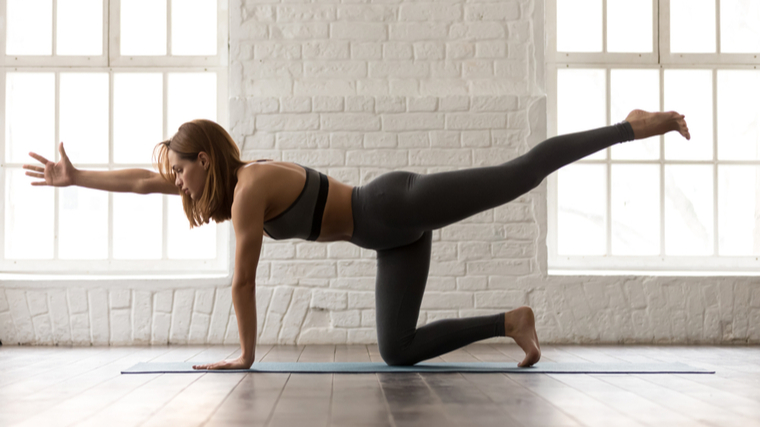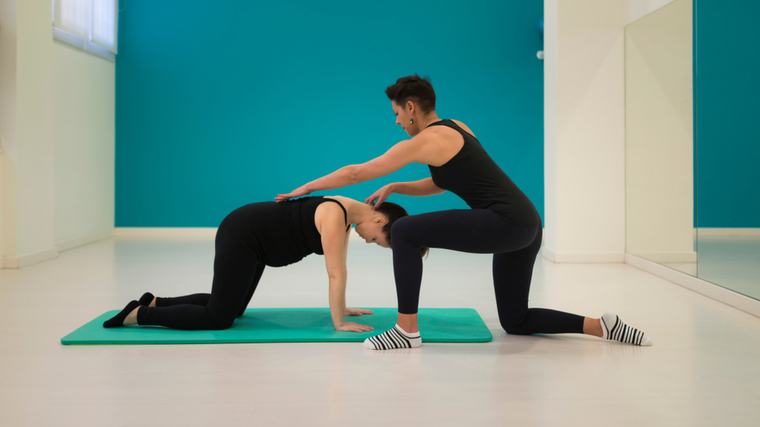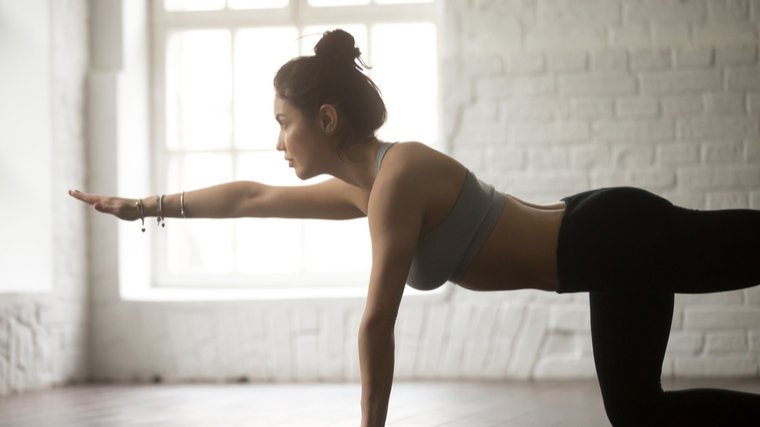Imagine your favorite workout. For strength and functional fitness athletes, this fantasy likely features a training session involving barbells, a load of bumper plates, or a Rogue echo bike. At the very least, you’re probably picturing a set of dumbbells, a plyo box, or battle ropes. If you’re a strength athlete, a bit of quiet, your bodyweight, and a yoga mat probably don’t make the cut.
As a humble bodyweight move, the bird dog might not make a lot of strength athletes’ lists of their top favorite exercises. But this balance-oriented core challenge stands on its own as a powerful way to improve your overall lifting game. With carryover potential into your heaviest lifts — think deadlifts and squats, which require a lot of full-body stability and core bracing — the bird dog isn’t your average warm-up activity.

To pull off a proper bird dog, you’ll grab a mat and get into a quadruped position — knees under your hips and hands under your shoulders. You’ll move slowly as you extend the opposite arm and leg out straight, kind of like an offset quadruped superman position. It can be more than a little humbling to move so slowly without weight, fighting for balance. But that jolt of humility — and the array of core-boosting benefits that come with it — might just be what your program is lacking.
- How to Do the Bird Dog
- Bird Dog Sets and Reps
- Common Bird Dog Mistakes
- Bird Dog Variations
- Bird Dog Alternatives
- Muscles Worked by the Bird Dog
- Benefits of the Bird Dog
- Who Should Do the Bird Dog
- Frequently Asked Questions
How to Do the Bird Dog
The bird dog is all about intention and deliberation. Especially if you’re used to fast, explosive movements, this exercise will force you to slow down and experience balance in real time.
Step 1 — Set Up

Get into a quadruped position by placing your hands directly underneath your shoulders and your knees under your hips. Establish a neutral spine.
Coach’s Tip: Perform a couple of cat cows — inhaling as you pull your belly toward the ground and lift your head up, exhaling as you arch your back upward toward the ceiling. Find a middle ground between these curved extremes to find a neutral position that works for your body.
Step 2 — Extend Opposite Limbs

Ground down into your left hand and right knee and toes for balance. Very slowly, lift your right hand and left knee and toes off the floor. Inhale as you extend your right arm forward. At the same time, straighten your left leg arm and extend it back. Lengthen through both limbs. Keep your core tight and your hips squared.
Coach’s Tip: Imagine balancing a yoga block or water bottle on your lower back and between your shoulder blades. To keep them steady, press your left hand and right knees and toes into the floor actively throughout the move.
Step 3 — Return to Start and Repeat

Once you reach full extension, maintain the position for a beat. On an exhale, slowly bring your left leg and right arm back toward your body. Repeat for reps. Keep your repetition number even on both sides.
Coach’s Tip: If your body allows this movement, you can curl your elbow and knee underneath you to finish off the rep, aiming to touch each other gently. The purpose of the knee-to-elbow touch is to maximize balance and core engagement. If your limbs can’t comfortably pass under your body, focus instead on contracting your core very hard with your back slightly curled — almost like a crunch from a quadruped position.
Bird Dog Sets and Reps
The bird dog is definitely one of those moves that’s about quality rather than quantity. It’s also crucial to place it strategically in your program. You might be performing the move as a means to help you warm up. Or, you might do the bird dog in supersets to activate your core and maintain focus between big barbell lifts. You may also use bird dogs as a central part of your core training.
- For Warming Up: Perform two to three sets of 10 to 12 reps per side.
- For Core Strength: During your core routine, do three to four sets of 15 to 20 quality reps per side.
- For Supersetting With Strength Lifts: In between sets of your big barbell exercises, perform a set of five to eight reps per side.
No matter where you’re putting bird dogs into your program, make sure you’re proceeding slowly and deliberately. Rushing through your reps will minimize the benefits of the move. If it helps, think of it as not just a core exercise, but as one for your mental discipline, as well.
Common Bird Dog Mistakes
It’s “just” a bodyweight move, you might say. How badly can you mess that up? Bodyweight moves can be pretty tricky, especially when balance is involved. Make sure you’re not making these common mistakes with the bird dog.
Moving Too Quickly
If your mindset with bird dogs is to get them done just because you should, you probably need to slow down your reps. Tuning into your breathing can help you slow down your movement. Inhale slowly as you lengthen your body and exhale slowly as you curl back in. By maintaining focus on your breath to help you move slowly will allow you to maximize the exercise’s benefits and avoid sloppy form.
Not Engaging the Ground
It’s easy to focus on your moving limbs during this move. But the arm and leg that you’re extending aren’t the ones maintaining your balance. Focus on pressing down into the ground with your non-moving hand, knee, and toes.

This will help prevent you from shifting your hips and shoulders during the movement. It will also maximize your core engagement, which is one of the principal points of this exercise.
Shifting Your Hips
As you extend an opposite arm and leg, your hips are naturally going to want to shift from side to side. This hip shift deactivates your core, which, when squeezed, will keep your hips locked into place. To avoid tilted hips, press down into the floor with your unmoving limbs. Keep your core tight the entire time. Not only will this make the exercise more effective, but it will also help train you to keep your core engaged during bigger lifts.
Bird Dog Variations
The bird dog in and of itself is a stellar way to improve core strength and full-body balance and stability. But if you’re looking for some extra spice, there are a few variations that can really up the ante.
Twisted Bird Dog
For this twist on the regular version, you’ll add an extension to your usual stopping point. You won’t just reach all the way forward and keep your shoulders neutral. The twisted bird dog calls for you to turn up and away from your body at the top of the move.
Track your eyes across the ceiling while you’re twisting upward. Even though you’re opening up through your chest, still keep your hips as neutral as you can. In doing so, you’ll add an extra rotational challenge to an already balance-heavy move.
Renegade Bird Dog Row
To perform this one, you’ll start in a push-up position instead of a quadruped position. Already, that makes the move more challenging because you have reduced points of contact with the ground. Instead of extending your moving arm up and away, you’ll perform a renegade row with a dumbbell.
Make sure you find balance once you elevate your leg with your dumbbell in hand. It might take a few seconds to stabilize before you start your actual row. Then, squeeze your shoulder blades at the top of the row to maximize upper back engagement and help you reestablish balance.
Elevated Bird Dog
Don’t be surprised if this one leaves you trembling. You’ll set up the same way, but instead of keeping your unmoving knee planted on the ground, you’ll raise it an inch or two. It will hover just above the ground while you perform your bird dog — and your core will feel the difference.
This reduces your points of contact with the ground. Doing so creates an even bigger challenge to your balance. The greater instability of this move will make it even more challenging to avoid shifting your hips. Your core will have to work even harder as a result.
Bird Dog Alternatives
The bird dog might be discussed as a “basic” exercise, but that doesn’t mean it’s easy. If you need an alternative, here are some scaled versions that can offer you similar benefits.
Standing Bird Dog
This move combines a forward-facing scapular slide with a soft straight-leg kickback. You’ll perform this move while standing close to a wall. You’ll extend one arm above you and extend your opposite leg back behind you.
Your range of motion will be reduced here, but that’s the point. You’ll be able to build more stability from a standing position, without having to put any pressure on your wrists or knees in a quadruped position. If moving different limbs in opposite directions at the same gets confusing for you, this is also a great way to get your brain around the move.
Cat Cow
Once you’re ready to transition your bird dog to the ground, start by practicing cat cows. On an inhale, you’ll press your belly down toward the ground and raise your chin to the ceiling. With an exhale, arch your back — yes, like a cat — toward the ceiling and tuck your chin toward your chest.
During the full bird dog, you can use a couple of cat cow repetitions to center yourself and find a neutral spine position. This move also helps you get comfortable in the quadruped position. You’ll also learn more about matching your breathing to your movement, which is a big part of the bird dog.
Muscles Worked by the Bird Dog
Let’s not beat around the bush — or, the bird’s nest — the bird dog isn’t primarily about growing big and strong. That said, your muscles will be working hard, across your whole body.
Rectus Abdominis
First and foremost, people tend to think about the bird dog as a core exercise — and with good reason. Your rectus abdominis, that front part of your core, will be working hard to keep you stable during this move. The isometric holds involved in this move will also activate your deep core.
Erector Spinae
It’s not all about those six-pack muscles. Your back is, indeed, part of your core. It will be working plenty hard during this move. You’ll be supporting your upper body on one hand, which involves some serious buy-in from your back. On top of that, your back will be one of the key components of keeping your body stable.
Glutes
Your glutes will kick in when you kick back with your moving leg. Since you’ll be moving so slowly, you’ll actually get quite a bit of time under tension for your glutes. Squeeze them at your end range of motion for an added strength-building bonus.
Shoulders
Since your upper body will be supported by just one hand, the shoulder of your unmoving hand will be working plenty hard here. This is also true of your moving arm, which will be kept steady through your shoulder joint. You’ll also reach forward at the end range of motion, which involves your moving shoulder.
Benefits of the Bird Dog
There’s nothing lowly about this bodyweight move. The advantages of including this exercise in your routine each have a huge turnaround impact on your big lifts.
Increase Spinal Stability
One huge purpose of the bird dog is to promote spinal stability. Here’s how it works: By extending your opposite arm and leg, you’re targeting your erector spinae, which extends from your neck to your hip. Your erector spinae are responsible for the flexion and rotation of your spine, which is crucial here. You’ll also engage your core, glutes, and shoulders, bolstering your stability in these muscles.

This move gives a huge potential boost to your stability under load. You definitely want a stable framework during your heavy lifts, whether your specialty is the clean & jerk or the back squat. What’s more, the bird dog has stability-boosting capacity without putting your spine under load or shearing pressures.
Boost Core Strength
Bolstering your core strength with core-specific moves like this can have tremendous carryover to loaded barbell lifts. The bird dog doesn’t just teach you how to stiffen the muscles around your spine to create more rigidity. It also helps build the strength you need to remain rigid under intense loading pressures. A strong core with a rigid spine won’t rotate or flex while deadlifting. So, if you have a case of cat-back while pulling heavy from the floor, then the bird dog may be the move you need.
Enhance Balance and Coordination
If you’ve ever tried a bird dog absentmindedly, you’ve probably wound up staring at the ceiling after tipping over. You’re holding your core rigid and steady while moving opposite limbs.
It’s a little bit like rubbing your tummy and patting your head at the same time — you’ll lift your left arm at the same time as your right arm. That can be a lot of coordination for many lifters to sort out, especially if they’re used to bilateral lifts where you’re moving the same way across sides.
Teaches Breathing Techniques
The bird dog requires you to inhale while you’re lengthening and exhale while you’re contracting back to center. Focusing on your breath teaches you to sync your inhales and exhales with your muscle movements. That’s tremendously beneficial if you’ve ever struggled to manage your breath during long squat sessions.
Letting your breath guide your movement also keeps you moving at a slow, measured pace. This will help prevent sloppy form and let you really maximize your gains.
Who Should Do the Bird Dog
The bird dog is beneficial for a whole host of lifters, especially those who are interested in building a firm foundation before loading up weight. Here are some types of athletes who can benefit from this move.
Powerlifters
Since powerlifters don’t have an overhead competition lift, they may not get as much time reaching out and overhead as they could. The bird dog provides a low-impact, unloaded method of improving shoulder and midline stability.
And lest you object that powerlifters don’t lift overhead so don’t need shoulder stability, your shoulders keep your position stable during the bench and even your back squat. Keeping them strong, engaged, and stable — along with your core — is key.
Olympic Weightlifters
It’s especially important for Olympic weightlifters to have a lot of midline and overhead stability. When you’re pressing and snatching huge amounts of weight overhead, you need to be able to trust your stability and coordination. Enter the bird dog. You can train your core strength and spinal stability without the pressure of a heavy barbell. This is potentially much easier on your back, joints, and overall recovery.
Non-Competitive Athletes
You don’t have to have a competition in sight to benefit from integrating this puppy into your routine. The bird dog can become a central part of your core routine. Even if you’re just training on the weekends, the bird dog can help your core strength take off.
Take Flight
The bird dog is a well-known exercise for a reason. You need a strong core and balance for everything from day-to-day activities to heavy overhead presses. The bird dog provides both of these in spades. Whether you’re using this move as a warm-up, core-builder, or both, the bird dog deserves to fly into your program and stay there.
FAQs
The bird dog looks simple, but it can take some practice to nail your technique. Here are some of the questions a lot of lifters have when they’re first starting out.
How do I know if my hips are squared during the bird dog?
Try balancing a yoga block across your lower back during the lift. This way, you’ll get immediate feedback about whether your hips are shifting during movement. You can also imagine tucking your unmoving hip slightly toward the ground for added stability during the move.
What if I keep tipping over during the bird dog?
For many athletes, it’s tempting to move quickly to try and eke out your reps before you topple over. But moving too fast can actually make you lose your balance faster — and also cancel out the benefits of going slowly and deliberately, which increases muscle engagement. On the other hand, moving slowly can feel like a recipe for losing balance.
Press down into the floor with your unmoving hand, knee, and foot. Trying to focus on staying grounded rather than focusing so much on your moving limbs. Moving with your breath — lengthen on an inhale, come back in on an exhale — can also help you maintain balance. It’s okay if you need to take your time building up your balance and coordination. Be patient with yourself and keep trying.
Featured Image: fizkes / Shutterstock